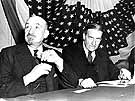
|
|
|

|

|

|

|
|
Click on an image to see a larger, more detailed picture.
|
|
|
|
|
| 1942: The "Final Solution" |

|
pg. 380 |

|
|
|
|
| |
 Several men, probably Jews, are executed in Lvov, Ukraine, in 1942. At the time of the German invasion of the Soviet Union, there were about 160,000 Jews in Lvov. When the Germans occupied the area, they turned the local Ukrainian population loose on local Jews, thousands of whom were tortured and killed even before the establishment of the ghetto. In December 1942 the Lvov Ghetto was liquidated, with most of its Jews sent to the Belzec extermination camp.
Several men, probably Jews, are executed in Lvov, Ukraine, in 1942. At the time of the German invasion of the Soviet Union, there were about 160,000 Jews in Lvov. When the Germans occupied the area, they turned the local Ukrainian population loose on local Jews, thousands of whom were tortured and killed even before the establishment of the ghetto. In December 1942 the Lvov Ghetto was liquidated, with most of its Jews sent to the Belzec extermination camp.
Photo: National Archives / United States Holocaust Memorial Museum Photo Archive
|
 German Order Police humiliate Jews during an Aktion in Lukow, Poland, in 1942. Almost 4000 Jews were murdered during the liquidation of the ghetto on May 2, 1943. Obvious Jewish symbols--such as prayer shawls, yarmulkes, and beards--made Jews seem "more Jewish" and left them especially vulnerable to German assault.
German Order Police humiliate Jews during an Aktion in Lukow, Poland, in 1942. Almost 4000 Jews were murdered during the liquidation of the ghetto on May 2, 1943. Obvious Jewish symbols--such as prayer shawls, yarmulkes, and beards--made Jews seem "more Jewish" and left them especially vulnerable to German assault.
Photo: Yad Vashem Archives
|
 Jewish Response in U.S.
Jewish Response in U.S.
When news reports about the mass murder of Eastern European Jews first reached the United States, the American Jewish community was ill prepared to deal with the impending tragedy. The lack of organizational cohesiveness and the disparate character of the American Jewish community prevented a unified response to the genocidal campaigns of the Nazis. The U.S. Jewish defense organization, known as the American Jewish Committee, used quiet diplomacy to deal with the Nazi onslaught. As the crisis in Europe escalated, the committee joined with seven other organizations to form the Joint Emergency Committee on European Jewish Affairs. This group submitted a rescue proposal to the Bermuda Conference and sponsored mass meetings to publicize the murder of European Jews. The creation of the American Jewish Conference in August 1943 was an attempt to promote Jewish unity and offer a unified response to the growing disaster in Europe. The conference's focus on postwar Jewish policy, however, limited the group's efficacy. Pictured here are Chaim Weizmann (left), Zionist activist and first president of the state of Israel, and Rabbi Stephen Wise, a founder of the American Zionist movement.
Photo: United States Holocaust Memorial Museum Photo Archive
|
|

|

|

|

|
 October 23, 1942: The Battle of El Alamein begins in Egypt; See November 2, 1942.
October 23, 1942: The Battle of El Alamein begins in Egypt; See November 2, 1942.
|
 October 23, 1942: Algerian-Jewish resistance leader José Aboulker meets with American General Mark Clark in Morocco. Aboulker is given 800 Sten guns, 800 grenades, 400 handguns, and 50 portable radios; See November 8, 1942.
October 23, 1942: Algerian-Jewish resistance leader José Aboulker meets with American General Mark Clark in Morocco. Aboulker is given 800 Sten guns, 800 grenades, 400 handguns, and 50 portable radios; See November 8, 1942.
|
 October 24, 1942: 252 friends and relatives of persons from Lidice, Czechoslovakia, are murdered at the camp at Mauthausen, Austria, in reprisal for the assassination of Reinhard Heydrich.
October 24, 1942: 252 friends and relatives of persons from Lidice, Czechoslovakia, are murdered at the camp at Mauthausen, Austria, in reprisal for the assassination of Reinhard Heydrich.
|
 October 25-26, 1942: Male Jews in Norway are arrested and sent by sea to Szczecin, Poland, then by railcar to Auschwitz; See November 25, 1942.
October 25-26, 1942: Male Jews in Norway are arrested and sent by sea to Szczecin, Poland, then by railcar to Auschwitz; See November 25, 1942.
|
|
|
|
|
| 1942: The "Final Solution" |

|
pg. 380 |

|
|
The Holocaust Chronicle
© 2009 Publications International, Ltd.
|
|
